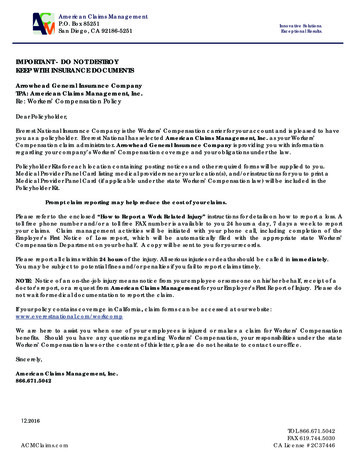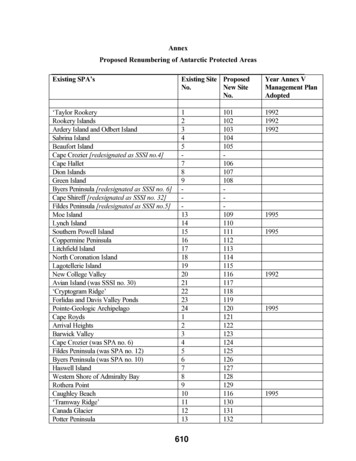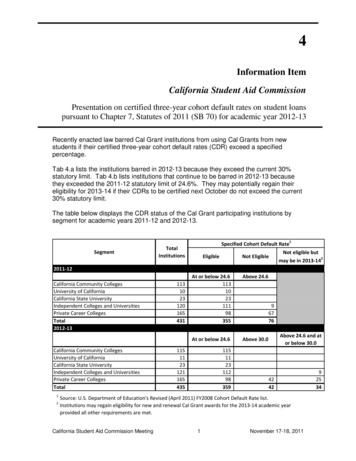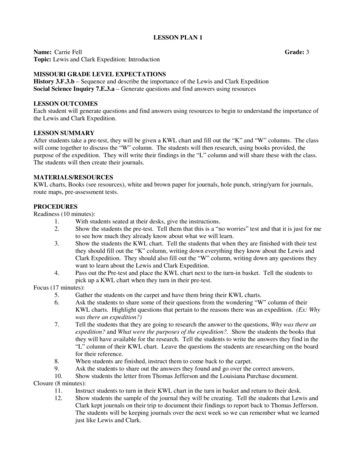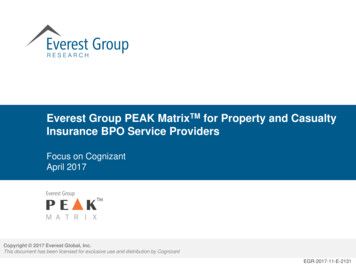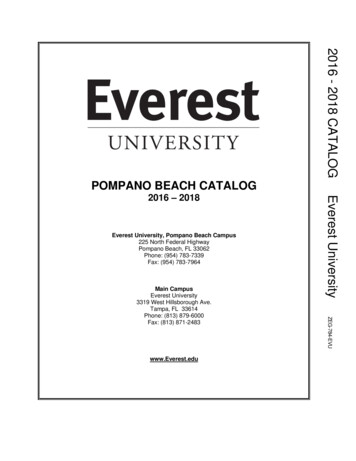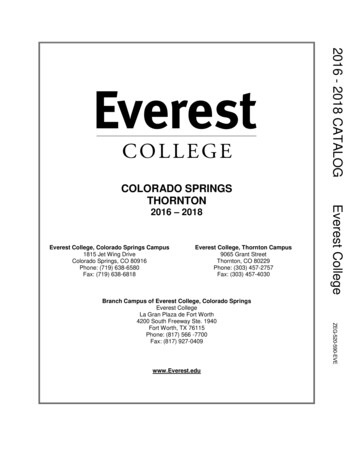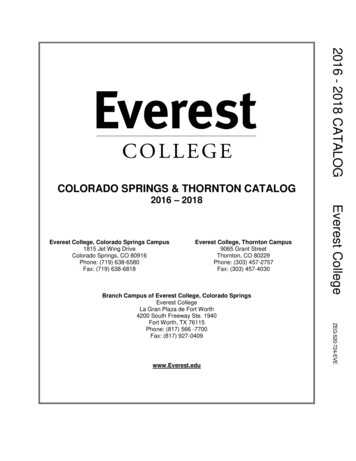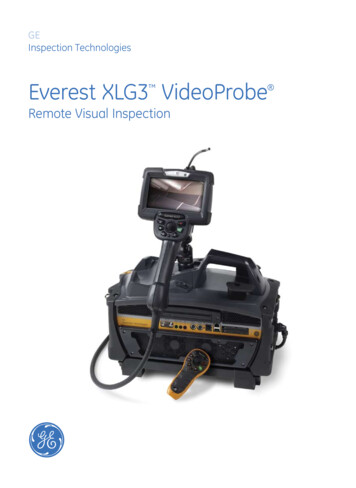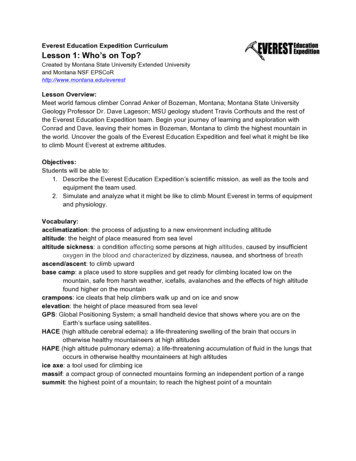
Transcription
Everest Education Expedition CurriculumLesson 1: Who’s on Top?Created by Montana State University Extended Universityand Montana NSF EPSCoRhttp://www.montana.edu/everestLesson Overview:Meet world famous climber Conrad Anker of Bozeman, Montana; Montana State UniversityGeology Professor Dr. Dave Lageson; MSU geology student Travis Corthouts and the rest ofthe Everest Education Expedition team. Begin your journey of learning and exploration withConrad and Dave, leaving their homes in Bozeman, Montana to climb the highest mountain inthe world. Uncover the goals of the Everest Education Expedition and feel what it might be liketo climb Mount Everest at extreme altitudes.Objectives:Students will be able to:1. Describe the Everest Education Expedition’s scientific mission, as well as the tools andequipment the team used.2. Simulate and analyze what it might be like to climb Mount Everest in terms of equipmentand physiology.Vocabulary:acclimatization: the process of adjusting to a new environment including altitudealtitude: the height of place measured from sea levelaltitude sickness: a condition affecting some persons at high altitudes, caused by insufficientoxygen in the blood and characterized by dizziness, nausea, and shortness of breathascend/ascent: to climb upwardbase camp: a place used to store supplies and get ready for climbing located low on themountain, safe from harsh weather, icefalls, avalanches and the effects of high altitudefound higher on the mountaincrampons: ice cleats that help climbers walk up and on ice and snowelevation: the height of place measured from sea levelGPS: Global Positioning System; a small handheld device that shows where you are on theEarth’s surface using satellites.HACE (high altitude cerebral edema): a life-threatening swelling of the brain that occurs inotherwise healthy mountaineers at high altitudesHAPE (high altitude pulmonary edema): a life-threatening accumulation of fluid in the lungs thatoccurs in otherwise healthy mountaineers at high altitudesice axe: a tool used for climbing icemassif: a compact group of connected mountains forming an independent portion of a rangesummit: the highest point of a mountain; to reach the highest point of a mountain
Background Information:In spring 2012, a team of world class climbers led by mountaineer and author Conrad Ankerembarked upon a historic expedition to commemorate the 50th anniversary of the firstsuccessful American ascent of Mount Everest. In 1963, two Americans (Tom Hornbein and WilliUnsoeld) became the first to successfully climb Everest’s West Ridge then descend via theSoutheast Ridge, thus traversing the entire mountain. This was one of the most difficult highaltitude feats in mountaineering history. Several members of the team climbed the Southeastridge to honor this achievement.The climbers used the Southeast Ridge route, climbed by other Americans on the 1963 team.They conducted extensive scientific work on the mountain and will share the science of theHimalayas with students and the public.Because the Everest Education Expedition was tied to Montana State University and supportedby Montana EPSCoR — special emphasis was placed on bringing the excitement of science,discovery, and global adventure into classrooms across Montana and the nation.Scientific Research Mission of the Everest Education ExpeditionScientific research on the geology of Mount Everest will be a significant component of theEverest Education Expedition, as it was with the first American expedition to Everest in 1963.Previous research in the Everest region is limited in scope due to the obvious difficulties ofconducting field work under extreme conditions of elevation and topography.The research was directed towards: Gaining a better idea of the age of Mount Everest and rocks that comprise the massif(the compact and connected group of mountains around Mount Everest that includesEverest, Nuptse, Lhotse, and Khumbutse); Collecting a suite of samples to better date and describe the fossil-bearing marinelimestones that form the summit pyramid of Everest; Studying the major faults that cut through Mount Everest to better understand how andwhen they formed (in particular, the Qomolangma and Lhotse detachment faults); Measuring a new GPS-based elevation of the summit of Mount Everest with the mostmodern and accurate equipment available.(To learn more about the scientific mission of the Everest Education Expedition .htm.)
Activity 1: What We KnowLength: 10 minutesMaterials: Pocket folder for all Everest Education Expedition working documents (optional) Chart paper Markers Map of world / atlas / globe1. Tell your student that over the next several weeks, they will be shadowing an expeditionto Mount Everest to learn more about the history, geography, geology and culture of thismountain. This is an exciting way to be a part of an historic expedition commemoratingthe 50th anniversary of the first successful American ascent of Mount Everest. Explain toyour students that before starting this study, you are going to explore what they alreadyknow about Mount Everest.2. Make a KWL chart with your students. Label the top of three different pieces of chartpaper with the following titles: “What I Know About Mount Everest”, “What I Want ToKnow About Mount Everest”, and “What We Learned About Mount Everest”. (Using chartpaper will allow you to refer back to this chart over the next few weeks.) Have yourstudents brainstorm as a class what they know (or ‘think they know’) and want to knowabout Mount Everest. Record all student responses on the first two correlating charts.Save them to refer back to throughout and at the end of the unit.Activity 2: Meet the Team!Activity Length: 15 minutesMaterials: Computer/s with Internet access1. Explain to your class that during this study, they will be retracing the steps of worldfamous climber Conrad Anker of Bozeman, Montana; Montana State University GeologyProfessor Dr. Dave Lageson, MSU student Travis Corthouts (pronounced Corth-outs)and the rest of the Everest Education Expedition team during their attempt to summit (orclimb to the top of) Mount Everest.2. Tell your students that one of the climbers is world-famous adventurer, Conrad Anker,who they will “meet” by watching a video and listening to interesting facts about him.a. With your students, watch a short video of Conrad. This video is available athttp://www.montana.edu/everest/multimedia or on YouTube athttp://youtu.be/sap5XOi iZg You can read a transcript at the end of this lesson.b. After the video, you can share with you students some more information aboutConrad. Prior to the 2012 EEE, he had summited Everest twice and this is whathe thinks a person needs to successfully climb Mount Everest or other difficultpeaks. Ask your students if they think they have these characteristics. Confidence Mental determination
High pain threshold Ability to deal with drastic temperature changesc. Climbing Mount Everest is incredibly difficult and Conrad has a few good luck ritualsthat he always follows when he’s on a dangerous expedition. He always carries aphoto of his family, puts his left shoe on first, and brings a brand new pair of socks towear on the day he attempts to summit a mountain. Ask your class if they have anygood luck rituals. Why do they think people have good luck superstitions?3. Introduce your students to another climber who was a part of the expedition, Dr. DavidLageson. Watch a short video of Dave introducing the Everest Education Expedition andthe mission of the historic adventure. This video is available athttp://www.montana.edu/everest/multimedia or on YouTube athttp://youtu.be/8QavYlZgrF4 The transcript is at the end of this lesson.4. Your students can also meet Travis Corthouts, the MSU graduate student who was onthe Expedition. Watch a short video of Dave introducing Travis. This video is available athttp://www.montana.edu/everest/multimedia or on YouTube athttp://youtu.be/du-ZC3NyaZs The transcript is at the end of this lesson.5. Briefly share with your students the names of the other climbers who were a part of theEverest Education Expedition team. Each climber’s full biography and photograph canbe found at http://www.montana.edu/everest/about/index.htma. Cory Richards - One of National Geographic’s Adventures of the Year for 2012b. Sam Elias - Climber and skier from Coloradoc. Kristoffer Erickson - Climber, skier and photographer; Montana State Universitygraduate.d. Emily Harrington - Female Climber of the Year at the Teva Mountain Games andattended the Winter Olympic Games in Torino, Italy as a US climbingambassador.e. Phil Henderson - Utah River Based Manager at the National Outdoor LeadershipSchool.f. Mark Jenkins - Field staff writer for National Geographic magazine and theWriter-in-Residence at the University of Wyomingg. Hilaree O'Neill - Named by Outside magazine as one of the most adventurouswomen in the world of sports. She is also the mother of two small children.h. After these videos and short introductions, see what questions students wouldhave for the Team. Encourage scientific questions based on the Team’s mission.
Activity 3: Walking in Climber’s BootsLesson Length: 20 minutesMaterials: Chart pad Markers Mount Everest Expedition Equipment /Everest Expedition Equipment List.pdf Pocket folder for all Everest Education Expedition working documents (optional)CalculatorScale (optional)Drinking straws-one for each studentStopwatch or timer (one for each group of 4 students)BackpackFive heavy textbooksTeacher Prep Notes: Pre-test the simulation experiment on your own (Step 3 in activity below)before conducting it with your students. Students will need to walk up and down stairs for 30second intervals or have the space to walk at a quick pace for 30 seconds somewhere safe onyour school campus.1. Brainstorm with students all the clothes they have on. Ask them how much they thinkeverything they are wearing weighs. Allow students to guess, and then tell your studentsthat the clothing they are wearing weighs approximately 2-3 pounds.2. Ask your students if they can name another unit used to describe weight. Introduce (orremind) your students of the unit kilograms. Discuss with your students that kilogramsare part of the metric system of measurement used by nearly every country but theUnited States. In the United States, the metric system, including kilograms andkilometers is used in science and by the military. The Everest Education Expedition teamused metric measurements because it is the standard international system.3. Have your students individually convert the weight of their clothing into kilograms bydividing 2 pounds by 2.2 (to equal 0.9 or about 1 kilogram). Share the correct answerwith your students and correct errors.4. Now, ask your students how much they think their backpack weighs with a typical day’ssupplies in it (binders, textbooks, lunch, etc.). Allow students to guess, and then tell yourstudents that a typical 5th grader’s backpack weighs between 4 and 6 pounds. Again,have your students convert this into kilograms (1.8 to 2.7 kilograms).5. Read your students the Equipment List (available at the end of this lesson) for a typicalMount Everest climber. (Vocabulary included in this reading includes crampons, iceaxe, and GPS.) Tell them that climbers carry most of the items on the list in a backpack.Ask the students how much they think a backpack will weigh for a Mount Everestclimber. Take several responses before telling students that climbers carry an averageof 40 pounds of supplies while hiking above Mount Everest’s Base Camp. (Base Campis a place used to store supplies and get ready for climbing located low on the mountain,safe from harsh weather, icefalls, avalanches and the effects of high altitude found
higher on the mountain.) Have your students convert this to 18.14 kilograms. Theaverage Mount Everest climber probably weights around 170 lbs (77.11 kg) so they arecarrying approximately ¼ of their weight on their backs. Climbers’ carry light backpacksthat are around 20 lbs. (9.07 kg) when they are hiking to Base Camp and yaks carry therest. At elevations above 17,000 feet (5182 m), the height of a place measured fromsea level, it is extremely difficult to carry heavy packs due to the lack of oxygen in the air.6. Explain to students that to simulate what it is like to climb Mount Everest at extremealtitudes with the gear they would need, they are going to conduct an experiment usingtheir loaded backpacks, straws and a set of stairs. (If you do not have access to stairs,have students walk at a quick pace for one minute through the halls, around the schoolplayground or another safe area.) Explain the following steps of the experiment to thestudents. Divide your class into small groups of four students each and lead studentsthrough each step.a. Pass out materials for each group of four students: one backpack with five largetextbooks (approximately 10 pounds or 4.5 kilograms), one timer or stop watch,and four drinking straws (one per student).b. Have your students take turns in their groups wearing the backpack withtextbooks while climbing up and down the stairs for 30 seconds. One studentfrom each small group will climb the stairs at a time.c. Then, have students take turns in their small groups climbing up and down thestairs wearing the backpack with textbooks while breathing through a straw tosimulate constricted availability of oxygen.d. Lead a discussion with your students about what they experienced. Ask yourstudents:i. Did the added weight of the backpack make climbing the stairs difficult?ii. Were you out of breath after climbing the stairs with the backpack?iii. What was it like breathing through the straw while climbing the stairs withthe backpack?iv. Did you rest or take a break during the timing?v. Do you think climbers on Mount Everest have to take breaks whileclimbing?vi. Ask each student how much he or she weighs (or weigh them if you have ascale). Ask them to calculate how heavy their backpack would be if it wasequal to ¼ of their body weight. How much more weight would they have toadd to the 10 lb backpack to get it to be ¼ of their weight?
Activity 4: The Death ZoneLesson Length: 10 minutesMaterials: MSU Science Zone #30 “Can humans survive at high altitude” worksheet (one perstudent) f1. Tell your students that altitude is very difficult on climbers. Just like it was difficult tobreathe out of a straw, it is difficult for climbers to get enough oxygen to live. Explain toyour students that most climbers that summit Mount Everest use supplemental oxygen.Two members of this expedition will be climbing without any oxygen - Cory Richards (onthe West Ridge) and Mark Jenkins (on the Southeast Ridge route).2. Have your students read the MSU Science Zone sheet. (Vocabulary included in thisreading includes altitude, altitude sickness, acclimatization, HAPE, and ascend.)3. Have your students answer the questions on the worksheet and review the answers as aclass.NOTE: The “Try This!” section of this worksheet may be assigned as a take-home activity or youcan extend this lesson by using this activity in class.Tying it All Together:Use the following ongoing activities to reinforce each lesson’s concepts, tie lessons together,and make the lesson relate to your hometown. Grade for completion, management of datacollection, effort and participation throughout unit.1. “Mount Everest and Me” worksheets/Worksheet EverestandMe.pdfThis worksheet will be an ongoing activity for your students. In a table format, the “MountEverest and Me” Worksheet compares Mount Everest, Granite Peak (the highest peak inMontana), and your hometown. Using comparisons, the worksheet reinforces thelesson’s content while helping students put this knowledge into perspective bycomparing their home state and hometown. Have your students fill in the correlatingrows of the table after completing each lesson. This can be completed as a class orindividually.2. Everest Education Expedition Vocabulary Crossword ksheets/Worksheet Lesson1Crossword.pdfThis crossword puzzle reinforces vocabulary presented in each lesson. Have yourstudents fill in the correlating vocabulary words for each lesson’s puzzle after eachlesson.
Taking it Further:Conrad’s Training RegimeShare with your students how Conrad Anker trained for climbing Mount Everest.1. He maintains a high level of physical activity and never lets himself get out of shape.2. He gets aerobic exercise every day for at least a half hour or more.3. He does weight training.4. He does push-ups and sit-ups.5. He fits exercise into his day whenever he can. For example, he walks or bikes instead oftaking a car. He takes the stairs, not an elevator or escalator.6. He does micro-workouts. If he is ever stuck in an airport, he’ll go to a place where noone can see him and will do a small workout.7. He is mindful of what he eats. He avoids unhealthy ingredients such as trans fat.8. He does hand strengthening exercises. He carries around a hand exercise tool to workon his grip when he has some down time.9. He does lots of stretching.10. He gets his body used to being cold through activities like climbing without gloves orjogging with snowballs in his hands.11. He visualizes possible worst-case scenarios that could happen on a climb. He imagineswhat kind of challenges he will face and mentally prepares himself for what will be hard.Staying healthy and safe is about risk management and being prepared.12. To prepare his body for expeditions, he often fasts for a full 24 hours about once amonth so he is used to having very little food.Ask your students what they would need to change in their daily routine to train for climbingMount Everest if they were going to climb Mount Everest. Ask your students what part of thetraining would be the hardest or what parts they would not enjoy. Conclude this discussion byemphasizing the difficulty of climbing Mount Everest and the dedication it takes to prepare forthe climb.Walking the Walk:Have your students use a map with a scale to calculate how far it is from Base Camp to thesummit of Mount Everest and convert it into miles. Convert this measurement into somethingrelevant to students. Have your students imagine what walking this distance would feel likewhile breathing through a straw and carrying a backpack. Have your students write about what itwould be like to climb Mount Everest.Go Through the Dispatches:Read one chapter per week.
Video Transcripts:Conrad Anker transcripthttp://youtu.be/sap5XOi iZgHello. I'm Conrad Anker, leader of the 2012 Everest Education Expedition.Come join us as we learn more about the physical world.We'll go from base camp to the summit of our planet's highest mountain. We'll learn allsorts of great things, like how are there marine sediments on top of Mount Everest, howfast do glaciers move, and how does the human body react to high altitude.This and many other things are yours to learn at montana.edu/Everest.Dave Lageson transcripthttp://youtu.be/8QavYlZgrF4Hi. My name is Dave Lageson. I'm a geology professor at Montana State University inBozeman, and I'm a member of the 2012 Everest Education Expedition.We're going to be going to Kathmandu and then trekking into the base of Mount Everest,doing a lot of geological research, and trying to get a better understanding of the historyand origin of Mount Everest.Be sure and follow along the Expedition on our website, which iswww.montana.edu/everest.Be looking for updates and videos and various things that we're going to post to thatwebsite throughout the expedition.I hope you enjoy the experience as much as we will!Dave Lageson introduces Travis Corthoutshttp://youtu.be/du-ZC3NyaZsHi. I'm Dave Lageson. I'm a geology professor at Montana State University, and I'm amember of the 2012 Everest Education Expedition.We're really looking forward to learning some new things about the geology of MountEverest and exploring the fantastic history of this region through the eyes of a geologist.
I'm going to be working with my new graduate student, Travis. He's a graduate ofMontana State University and he's a new graduate student in our department. Hismaster's thesis will be based on the geology of Mount Everest.Hey, everyone. I'm looking forward to sharing the awesome geology of the Everestregion.I hope you enjoy it.
Pocket folder for all Everest Education Expedition working documents (optional) Chart paper Markers Map of world / atlas / globe 1. Tell your student that over the next several weeks, they will be shadowing an expedition to Mount Everest to learn more about the history, geography, geology and culture of this mountain.

